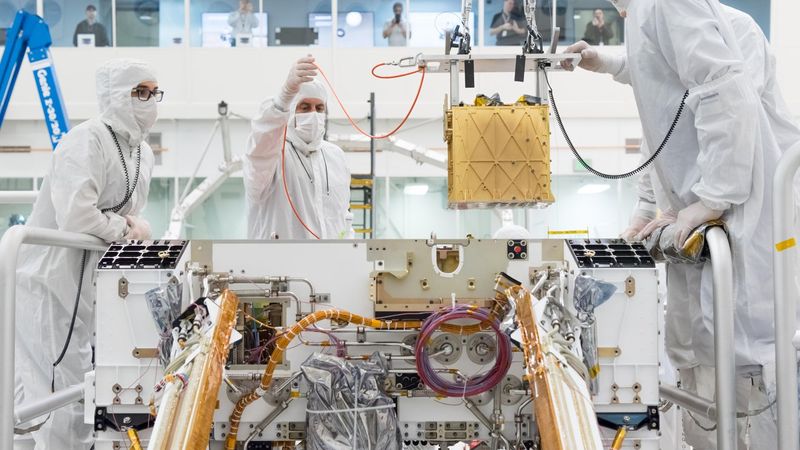Breathtaking Success on Mars: MOXIE Experiment Delivers as Promised
MOXIE successfully turned Martian carbon dioxide into usable oxygen – a monumental achievement with even bigger implications for the future of space exploration

NASA/JPL-Caltech
This article was discussed in our Next Byte podcast.
The full article will continue below.
Think about this: while we're here on Earth, a device on Mars (called MOXIE) is breathing life into our interplanetary ambitions by turning carbon dioxide into oxygen. And it's not just working; it's thriving.
The minds behind the mission
The team behind the Mars Oxygen In-Situ Resource Utilization Experiment, colloquially known as MOXIE, was led by principal investigator Michael Hecht from MIT but also includes collaborators from Caltech as well as OxEon Energy. Stationed on NASA's Perseverance rover, which was designed and managed by NASA JPL, this compact device is making interstellar history.
The drive to innovate
Fundamentally speaking, there will be a massive demand for oxygen in a society that is interplanetary – it is not only required to sustain life but is also necessary for the combustion of rocket fuel. The roots of MOXIE's endeavor trace back to the persistent challenge in space exploration: resource transport. Carrying massive oxygen tanks across the vast expanse between Earth and Mars is logistically daunting and downright uneconomical. Thus, the inception of MOXIE: to negate this transportation need by producing oxygen right on the Red Planet.
Fast forward to today, MOXIE hasn't just met expectations; it's exceeded them. From the time of its Martian touchdown in February 2021, the instrument has not only produced oxygen consistently, but it has also done so under varied atmospheric conditions and at different times, day and night. Its performance, irrespective of the fluctuating Martian atmosphere, stands as a testament to its engineering excellence.
MOXIE's breathtaking success
Between its start-up in February 2021 and September 2023, MOXIE accumulated a total output of 122 grams of oxygen. At maximum operational capacity, the system produced 12 grams of oxygen each hour, achieving a purity level of 98% or higher. The consistent target was six grams of oxygen per hour, a rate comparable to the oxygen output of a standard terrestrial tree. MOXIE matched or exceeded both its purity and volume targets during this experiment.
Impressively, MOXIE's oxygen production was also consistent across Mars' intense seasonal variation. Because of vast differences in temperature between seasons, Mars' atmospheric density can vary up to twofold throughout the year, which presents a dynamic environment for MOXIE's oxygen production.
The secret sauce behind MOXIE
The wizardry of MOXIE is both fascinating and profoundly technical, ingeniously designed to work under the highly variable Martian conditions.
MOXIE begins its operations by first drawing in carbon dioxide-rich Martian air, which is filtered to rid contaminants. The air is subsequently pressurized and channeled through the Solid OXide Electrolyzer (SOXE), which was developed by OxEon Energy. SOXE electrochemically dissects the air into oxygen ions and carbon monoxide. The oxygen ions are skillfully isolated and recombined, resulting in molecular oxygen, or O2. Before releasing it back into the Martian atmosphere (alongside carbon monoxide and other gases), MOXIE conducts tests to determine whether the oxygen's quantity and purity meet the mark.
Furthermore, accommodating MOXIE's function within the Perseverance rover's busy schedule demanded adaptability. Designed to operate intermittently, MOXIE's performance during various times of the Martian day and throughout diverse seasons showed its resilience. While full-scale versions of MOXIE are envisioned to run continually, the current design's episodic functioning has demonstrated robustness against potential wear and tear.
Beyond the experiment
Following MOXIE's success, the research group still sees lots of future work on the horizon for in-situ oxygen production, including designing a future full-scale system that is designed to run nonstop (the current system is designed to operate only in short bursts). The ultimate goal is to a dispatch larger version of MOXIE to Mars and allow it to produce and store up large quantities of oxygen to support future missions.
All in all, this isn't just a technological win; it's a game-changer. MOXIE's proven ability to transform plentiful Martian carbon dioxide into oxygen means the dream of return flights from Mars – and perhaps eventual manned exploration – is a significant step closer. MOXIE has not just created oxygen but also started paving the path for humanity's next big interplanetary leap.

